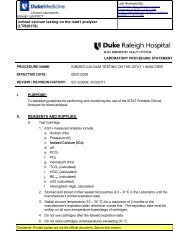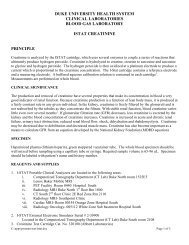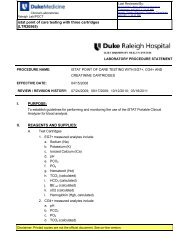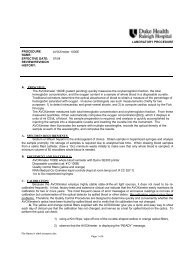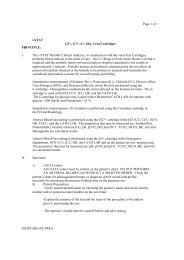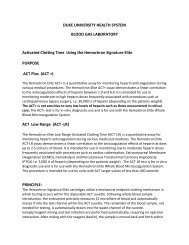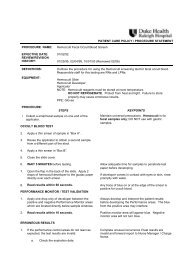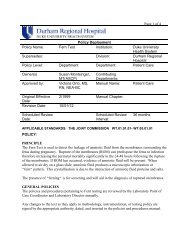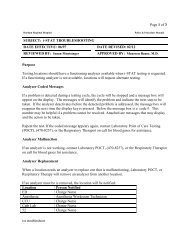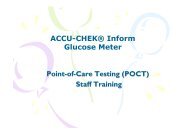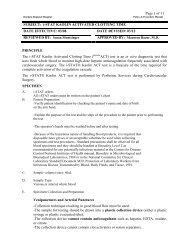whole blood prothrombin time using hemochron jr. signature ...
whole blood prothrombin time using hemochron jr. signature ...
whole blood prothrombin time using hemochron jr. signature ...
Create successful ePaper yourself
Turn your PDF publications into a flip-book with our unique Google optimized e-Paper software.
WHOLE BLOOD PROTHROMBIN TIMEUSING HEMOCHRON JR. SIGNATURE INSTRUMENTPURPOSETo determine a quantitative, one-stage <strong>prothrombin</strong> <strong>time</strong> in <strong>whole</strong> <strong>blood</strong> at the bedsidefor adult patients.PRINCIPLEThe HEMOCHRON Jr. instrument utilizes a mechanical endpoint clotting mechanism inwhich testing occurs within the disposable PT cuvette. Following <strong>whole</strong> <strong>blood</strong> sampleintroduction, the instrument precisely measures 15 microliters of <strong>blood</strong> andautomatically moves it into the test channel within the PT cuvette. After mixing with thereagent, the sample is moved back and forth within the test channel and monitored forclot formation. The instrument recognizes that the clot endpoint has been achieved whenthe movement decreases below a predetermined rate. The instrument reports <strong>whole</strong><strong>blood</strong> numbers mathematically converted to an International Normalized Ratio (INR) anda plasma equivalent value.SPECIMENFresh capillary <strong>whole</strong> <strong>blood</strong>. Blood can be obtained by puncturing the fingertip. Test the<strong>blood</strong> immediately after collection. The sample must be free of bubbles and microclots.Finger puncture: Clean the area and allow to thoroughly dry. Insert test cuvette into the instrument, allowing warming of the instrument. Puncture the skin to get free flowing <strong>blood</strong>. Avoid excessive squeezing of the puncture site. Wipe the first drop of <strong>blood</strong> with dry gauze. Apply the second drop of <strong>blood</strong> into the sample well of the test cuvette. Depress the START key. Document displayed PT, INR on Coag WB PT Form and Anticoagulation Clinicflow sheet. Discard lancet and cuvette in biohazard receptacle.PERSONNELFollowing demonstration of clinical competency, RNs, PA-Cs, and PharmDs mayperform Whole Blood PT testing. Competency must be six months after initial trainingfor new employees and annually, in September, thereafter.1
LIMITATIONS AND PRECAUTIONS OF THE PROCEDURE1. Whole <strong>blood</strong> second values less than 15 or greater than 170, are displayed asplasma equivalent (PT-P) values of “PT80 sec”.2. INR values between 0.5 and 0.8 and between 10 and 12, are displayed as“INR10”. INR values under 0.5 and over 12 are displayed as“Out of Range-Lo” and “Out of Range-Hi”.3. Samples with a hematocrit less than 20% or greater than 55% are notrecommended.4. Do not collect fresh <strong>whole</strong> <strong>blood</strong> samples <strong>using</strong> glass <strong>blood</strong> collection tubes.5. Do not obtain <strong>blood</strong> from heparinized access line, lock or indwelling heparin lock.6. Never use body fluids, serum or plasma.7. Results are affected by poor technique including <strong>blood</strong> collection and the transferof <strong>blood</strong> to the sample well. The quality of the <strong>blood</strong> specimen may be affectedby: Foaming or hemolysis of the sample Clotted or partially clotted <strong>blood</strong>. Unsuspected anticoagulation Lupus anticoagulant8. Do NOT use cuvettes that are past their marked expiration date, or that have beenimproperly stored.9. Do NOT force a cuvette into the instrument. If resistance to insertion isencountered, gently remove the cuvette and examine the cuvette slot. Remove anyobstruction before attempting further use of the instrument.EQUIPMENT AND MATERIALSEquipment: HEMOCHRON Jr. Signature instrument Lancing device Alcohol prep pads 2 x 2 gauze padsMaterials Preloaded HEMOCHRON Jr. PT test cuvettes: When refrigerated (2-8°C), thefoil pouched PT cuvettes are stable until the marked expiration date. PT cuvettesshould not be exposed to temperatures in excess of 37°C. Electronic System Verification Cartridges: normal range, abnormal range,temperature verification2
QUALITY CONTROLVerify the HEMOCHRON Jr. performance once per every 8 hours of operation, <strong>using</strong> theElectronic System Verification Cartridges. (normal range, abnormal range, temperature)Procedure Insert cartridge into the instrument. Follow prompts displayed on LCD screen. “Press E-QC” – press “start” button on cartridge “E-QC = ____ sec” – document value on WB PT form and verify that value is inacceptable range. Perform for both normal range and abnormal range cartridges.Abnormal range (acceptable range 299-310 sec)Normal range (acceptable range 25-35 sec) Insert temperature cartridge. Read temperature displayed directly on cartridge.Acceptable temperature: 37±1°C. Record value on WB PT form3




